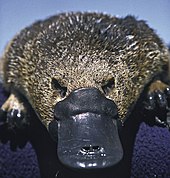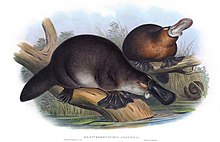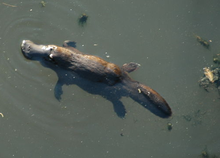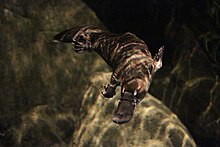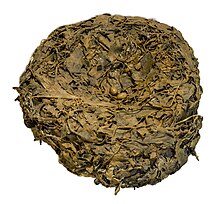Ornithorhynchus anatinus
The platypus (Ornithorhynchus anatinus) is a species of semi-aquatic mammal endemic to eastern Australia and the island of Tasmania. It is one of the five species —along with the four echidnas— that survive today in the order of monotremes, a group that brings together the only current mammals that lay eggs instead of giving birth to live young. It is the only living representative of the family Ornithorhynchidae and of the genus Ornithorhynchus.
The unusual appearance of this mammal—egg-laying, venomous, with a duck-billed snout, beaver tail, and otter feet—puzzled European naturalists when they first encountered it, even becoming considered by some to be an elaborate forgery. It is one of the few extant venomous mammals; males have a spur on their hind legs that releases a venom capable of causing intense pain to humans. Its unique features make it an important subject of study in the field of evolutionary biology, as well as a recognizable and iconic symbol of Australia; it has appeared as a mascot at national events and is featured on the reverse of the Australian 20p coin. It is the animal emblem of the state of New South Wales.
Until the beginning of the 20th century, it was hunted for its skin, but it is currently protected throughout its range. It is not considered to be under immediate threat, although captive breeding programs have had rather limited success, and it is a vulnerable species to the effects of pollution.
Taxonomy and etymology
When the platypus was first discovered by Europeans in 1798, Captain John Hunter, 2nd Governor of New South Wales, sent a sketch and the skin of a specimen to Great Britain. animal, British scientists believed they were dealing with a fraud. George Shaw, who in 1799 made the first description of the platypus in the journal Naturalist's Miscellany, stated that it was impossible not to have shown doubts about its authenticity and Robert Knox believed it might have been created by some Asian taxidermist. It was believed that someone had sewn a duck's beak onto the body of a beaver-like animal. Shaw even used scissors to check the dissected skin for sutures.
Its common name in English, Platypus, is a Latinized term derived from the Greek words πλατύς (platys, flat, broad) and πους (pous, foot), "flat foot". Shaw assigned it as a Linnaean genus name when he first described it (the species name being Platypus anatinus ), but it was soon discovered that this genus name already belonged to wood beetles (genus Platypus). In 1800 it was independently described as Ornithorhynchus paradoxus by Johann Blumenbach, from from a specimen given to him by Sir Joseph Banks, and, following the rules of nomenclature priority, it was later officially recognized as Ornithorhynchus anatinus.
The scientific name is formed with Ornithorhynchus, which derives from the Greek word ornithorhynkhos (ὄρνις, -ιθος, bird, and ῥύγχος, beak); and anatinus, which is Latin for "duck-like." The common name in Spanish also comes from the Greek ornithorhynkhos.
Morphology
Usually deep brown on back and sides of head, body, and upper legs; the ventral region is a silky blond or gray color. The body and broad, flat tail are covered with thick fur that retains an insulating layer of air that keeps the animal warm. The tail is similar to that of the beaver, but unlike this one, which uses it to propel itself, the platypus only uses it to maneuver in the water; It also uses its tail as a storehouse for fat reserves, an adaptation also found in animals such as the Tasmanian devil (Sarcophilus harrisii). It has webbed feet and a large, broad, flat snout, covered with fur. soft and wet rubber-like in appearance; these traits are more like those found in a duck than those found in any known mammal. The membrane that it has between the toes of the front feet is larger than that of the hind legs and goes beyond the end of the fingers to achieve a greater pushing surface, since it is with the forelimbs that it moves with during diving. When moving on land, it folds the membrane backwards, exposing its strong claws.
Unlike a bird's beak, in which the upper and lower parts part to reveal the mouth, its snout is a sensory organ with the mouth at the bottom. The nostrils are located on the dorsal surface of the snout, while the eyes and ears are located in a groove just behind the snout; this groove closes when the animal swims. It has about half as many olfactory receptors as most mammals, but it does have the ability to smell underwater, a valuable adaptation during its underwater search for food. Researchers think this ability may have been gained when the platypus lineage underwent an expansion in the genes that code for a certain scent receptor called the vomeronasal receptor. Platypuses have been heard to make a low-pitched growl when disturbed, and in individuals various types of vocalizations have been recorded in captivity.
| Weight (kg) | Length (cm) | |||
|---|---|---|---|---|
| Body | Cola | Hocico | ||
| Macho | 1.0 - 2.4 | 45 - 60 | 10.5 - 15.3 | 5.8 |
| Female | 0.7 - 1.6 | 39 - 55 | 8.3 - 12,0 | 5.2 |
Weight varies considerably, between 700 and 2,400 g, and males are larger than females: males average about 50 cm while females measure about 43 cm. There are significant differences in size medium from one region to another. These differences do not seem to follow any specific climatic rule and could be due to other environmental factors such as predators or the presence of humans.
It maintains a body temperature of 31-32 °C, which contrasts with the 38 °C typical of placental mammals. Research suggests that this is a gradual adaptation to harsh environmental conditions by the small number of surviving species of monotremes, and not of a historical characteristic of them.
Pups have tricuspid molars that are shed before or just after leaving the burrow where they were born; adults instead have strong keratinous plates. Their jaws are configured differently from others mammals and the muscle that opens it is different. As in all true mammals, the small bones that conduct sound to the middle ear are fully embedded in the skull, rather than in the jaw, as in cynodonts and other premammalian synapsids.. However, the external ear opening still remains at the base of the jaw. The platypus has seven cervical vertebrae, the usual number in mammals, however it has additional bones in the shoulder girdle, including an interclavicle, which is not visible. found in other mammals, and shows some reptilian features in its skeleton. It also has a reptilian-like gait, with its legs positioned on the sides of the body, not under it, and, to avoid possible damage to the large interdigital web of its front legs, it moves by supporting itself on its knuckles.
Poison
Although both males and females are born with ankle spurs, only the male's release venom, composed primarily of defensin-like proteins (DLPs), three of which are unique to the platypus. Defensins are produced by your immune system. Although the venom is potent enough to kill small animals, or even dogs, it is not lethal to humans, although edema soon develops around the wound after a bite, gradually spreading down the affected limb and causing swelling. pain so intense that it cannot be relieved even with morphine. Information from case studies and anecdotal evidence indicates that the pain develops into a long-lasting hyperalgesia that persists for days or even months. The poison is produced in male femoral glands, kidney-shaped alveolar glands connected to heel spurs of both hind feet via a thin-walled duct. Females, like echidnas, are born with rudimentary spines that do not develop and fall off before they are one year old, and lack functional femoral glands.
The venom seems to have a different function than that produced by non-mammalian species; its effects are usually not lethal, but are powerful enough to seriously debilitate the victim. Since only males produce venom and production increases during the mating season, it is theorized that it is used as an offensive weapon to assert dominance during this period.
Electrolocation
Monotremes are the only mammals known to have a sense of electroreception; they locate their prey, in part, by detecting electrical fields generated by its muscular contractions. The electroreception of the platypus is the most sensitive of all monotremes.
Electroreceptors are located in rostrocaudal rows on the skin of the snout, while mechanoreceptors (which detect touch) are evenly distributed across the snout. The electrosensitive area of the cerebral cortex is located in the tactile somatosensory area, and some cortical cells receive stimuli from both electroreceptors and mechanoreceptors, suggesting a close association between the electroreceptive and touch senses. Both the electroreceptors and the mechanoreceptors of the snout dominate the somatotopic map of its brain, in the same way that human hands dominate the map of Penfield's cortical homunculus.
Can determine the direction of an electrical source, possibly by comparing differences in signal strength across the electroreceptor layer. This would explain the characteristic movement of the animal's head from side to side when hunting. The cortical convergence of electrosensory and tactile stimuli suggests the existence of a mechanism for determining the distance of prey that, when moving, emits both electrical signals and mechanical pressure pulses, which would also allow distance to be calculated from the difference. in the arrival time of the two signals.
The platypus does not forage for food by sight or smell, closing its eyes, ears, and nose when diving, and burrowing with its snout at the bottom of streams. The electroreceptors in its snout detect the small movements of its prey by distinguishing animate from inanimate objects in this situation where the mechanoreceptors are constantly stimulated. Prey would generate tiny electrical currents with their muscle contractions that could be detected by their sensitive electroreceptors.. It has been shown experimentally that the platypus reacts to an artificial "shrimp" if a weak electrical current is passed through it.
Ecology and behavior
It is a semi-aquatic animal and lives in small streams and rivers in a biogeographic area that has a wide variety of habitats and climates, ranging from the cold mountainous areas of Tasmania and the Australian Alps to the tropical forests of the coasts of Queensland. Its distribution is not known in the Australian outback; became extinct in South Australia, except for a population introduced on Kangaroo Island between 1929 and 1946 that still maintains active populations, and no longer inhabits much of the Murray-Darling Basin, possibly due to declining water quality caused by by logging and large-scale irrigation. Along coastal river systems, their distribution is unpredictable; it appears to be absent from some relatively healthy rivers, but continues to live in others that are quite degraded (such as the lower Maribyrnong River).
In captivity some specimens have survived up to seventeen years of age and wild specimens have been captured with an age of eleven years. The mortality rate of adults in the wild appears to be low. Natural predators include snakes, the Australian water rat (Hydromys chrysogaster), monitor lizards, hawks, owls, and eagles. The small populations in northern Australia are possibly due to crocodile predation. The introduction of the red fox in the mid-1800s for sport hunting and as a predator for rabbit may have had some impact on platypus numbers in Australia. the continent. As a general rule, it is a nocturnal and crepuscular animal, however there are active individuals during the day, particularly when the sky is covered. It usually inhabits elevated rivers and riparian areas, both due to the availability of prey and sandbanks where they dig burrows to nest and rest. A specimen can cover a territory of a radius of up to seven kilometers and, in the case of males, said territory overlaps that of three or four females.
The platypus is an excellent swimmer and spends much of its time in the water searching for food. When swimming, it can be distinguished from other Australian mammals by the lack of visible ears. One of its characteristics, unique among mammals, is that it swims by propelling itself in the water by alternately flapping its front legs; although its four legs are webbed, the rear ones, which it folds against the body, do not contribute to momentum but serve to steer, in combination with the tail. It is a homeothermic species that maintains its body temperature around 32 °C (lower than most mammals) even when foraging for hours in water below 5 °C.
Normally their dives last about 30 seconds; they can last longer but few exceed their estimated aerobic limit of 40 seconds. To recover from its dives, it spends between 10 and 20 seconds on the surface of the water. The platypus is carnivorous; It feeds on annelids, insect larvae, freshwater shrimp, and crayfish that it digs from the riverbed by digging with its snout or hunts while swimming. It uses maxillary sacs to store its food along with small stones that help it crush it. Once the sacs are full, or when it catches larger prey, it rises to the surface to eat the catch. It needs to eat about 20% of its weight each day. This implies that it has to spend an average of 12 hours a day looking for food. When it is not in the water, it retires to a small, straight resting burrow, oval in cross section, almost always located on the shore a little above the water level, and often hidden under a protective tangle of roots.
Playback
When Europeans discovered the platypus, scientists were divided on the question of whether the female laid eggs. This fact was not confirmed until 1884, when W. H. Caldwell was sent to Australia, where, after intensive research aided by a team of 150 Aboriginal people, he managed to find some eggs. Aware of the high price of sending a telegram to the UK based on cost per word, Caldwell sent a famous and laconic message to London: "Monotremes oviparous, ovum meroblastic". That is, monotremes lay eggs, and the eggs resemble those of reptiles in that only part of the egg divides during development.
The species has only one mating period; after an elaborate courtship that ends with the pair swimming together in slow circles, while the male holds the female's tail in his beak, copulation occurs between June and October, with some local variation throughout their range. distribution. Historical observation, studies based on mark-recapture, and preliminary population genetics investigations indicate the possibility of permanent and temporary members in populations, and suggest a polygynous mating system. that females become sexually active during their second year of life, and it has been confirmed that animals older than nine years of age still mate.
Outside of the mating season, the platypus lives in a simple earthen burrow, with the entrance about 30 cm above the water level. After mating, the female builds a deeper, more elaborate burrow up to 20 meters in length, plugging it at intervals, perhaps as protection against rising water levels or predators, or as a method of regulating humidity and humidity. temperature. The male plays no role in rearing the offspring, and withdraws to his burrow. The female lines and mulches the ground in the burrow with dead, damp leaves and fills the nest at the end of the tunnel with dead leaves and reeds to make bedding, where she will incubate her eggs. She drags this material to the nest by coiling it with her tail.
Females have one pair of ovaries, but only the left one is functional. They lay between one and three (usually two) small, leathery (reptile-like) eggs, about 11 mm in diameter and about 11 mm in diameter. slightly more rounded than those of birds. Eggs develop in the uterus for about 28 days, with only about 10 days of external incubation (unlike chicken eggs, which spend one day in the tract and three weeks outside). After laying these thin-shelled, sticky eggs, the female curls up around them, holding them against her belly with her tail. The incubation period is divided into three parts. In the first, the embryo lacks functional organs and is maintained thanks to the yolk sac. The yolk is absorbed by the developing young. During the second the fingers develop, and in the last the "egg tooth" appears.
Newborns are vulnerable, blind and hairless, and are fed with their mother's milk. Although it has mammary glands, it lacks nipples; the milk is released through the pores of the skin. The female has grooves on her abdomen that form milk rafts that allow the young to lick it up. After hatching, the young are nursed for three to four months. During the incubation and lactation period, the mother initially only leaves the burrow for short periods to forage. When she does, she creates a series of thin plugs of dirt along the length of the burrow, possibly to protect the hatchlings from predators; when she pushes these plugs during the return, they absorb water from her fur, allowing the burrow to remain dry. After about five weeks, the mother begins to spend more time apart from the young, and when they are about four months old, they abandon the burrow. Platypuses are born with teeth, but they fall out at a very young age, leaving horny plates with which they grind food.
Evolution
The platypus and other monotremes were very little known, and some of the 19th century myths that were invented about them (for example that they were "inferior" or near-reptilian) still persist. In 1947, William King Gregory theorized that placental mammals and marsupials might have diverged earlier and that a later branching divided monotremes and marsupials, but subsequent research and fossil discoveries have shown this hypothesis to be incorrect. In fact, modern monotremes are the survivors of an early branching of the mammalian tree, and a later divergence is thought to have led to the marsupial and placental groups. Molecular clock and fossil dating point to the separation of platypuses from platypuses. echidnas occurred approximately 19-48 million years ago.
The oldest fossil discovered of a modern platypus dates to about 100,000 years ago, during the Pleistocene period. The extinct monotremes (Teinolophos and Steropodon) were closely related to the modern platypus. A fossilized Steropodon was discovered in New South Wales, consisting of in an opalized lower jaw with three molar teeth (whereas the modern adult platypus lacks teeth). The molars were initially thought to be tribosphenic, which would have supported a variation of Gregory's theory, but later research suggested that, despite having three cusps, they evolved in a separate process. The fossil is believed to be about 110 million. years old, meaning this platypus-like animal lived in the Cretaceous period, making it the oldest mammalian fossil discovered in Australia. Monotrematum sudamericanum, another extinct relative of the platypus was discovered in Argentina, indicating that monotremes were present on the supercontinent of Gondwana when the continents of South America and Australia were linked via Antarctica.
Due to the early divergence of therian mammals and the reduced number of living monotreme species, the platypus is an important and frequent subject of study in the field of evolutionary biology. In 2004 researchers from the Australian National University discovered that it has ten sex chromosomes, in contrast to the two (XY) of most mammals (for example, a male will always be XYXYXYXYXY). XY designation of mammals, the platypus sex chromosomes are most similar to the ZZ/ZW sex chromosomes of birds. Its genome also contains both reptilian and mammalian genes associated with the fertilization of eggs. Since it lacks the SRY gene that determines sex in mammals, the sex determination process of the platypus is not yet known. A preliminary version of its genomic sequence was published in May 2008 in the journal Nature, showing elements from both reptiles and mammals, as well as two genes that had previously only been discovered in birds, amphibians, and fish.. The study found that more than 80% of its genes are common to mammals for which genes have been sequenced, and that the platypus genome, like the animal itself, is an amalgamation of reptilian ancestry and mammalian-derived features..
Conservation status
Except for its disappearance from the state of South Australia, the platypus occupies the same general distribution as it did before the European colonization of Australia. However, local changes and fragmentation of its distribution have been documented due to the modification of its habitat by humans. On the other hand, its current and historical abundance is not well known and it has probably suffered a decline in its populations, despite the fact that it is still considered common in most of its current range. The species was heavily hunted for its fur. until the early years of the 20th century and, despite being protected throughout Australia from 1905, until 1950 still was in danger of drowning in the nets of inland trawlers. The platypus does not appear to be in immediate danger of extinction due to conservation measures, but could be affected by habitat destruction caused by dams, irrigation and pollution and deaths from drowning when caught in the nets and traps set to capture fish and crustaceans. There are strict regulations that prevent its export, so it can only be found, both in the wild and in captivity, in Australian territory. The International Union for Conservation of Nature lists it as a near threatened species on its Red List, although some researchers consider that it should be classified as "potentially vulnerable" due to its dependence on aquatic environments threatened by drought, climate change, and degradation from human activities.
Platypuses generally suffer from few diseases in the wild; however in Tasmania there is great concern about the potential impact of a disease caused by the fungus Mucor amphibiorum. The disease (called 'mucormycosis') only affects Tasmanian platypuses, and has not been observed on the rest of the Australian mainland. Affected animals can develop unsightly skin lesions or ulcers on various parts of the body, including the back, tail, and feet. Mucormycosis can kill them; death is caused by secondary infections and because the animal's ability to maintain its body temperature and its efficiency when searching for food is affected. The Biodiversity Conservation Section of the Department of Primary Industries and Water is collaborating with various government departments and researchers from two Australian universities to determine the impact of the disease on Tasmanian platypuses, as well as the mechanism of transmission and spread of the disease. disease.
Most of the world was introduced to the platypus in 1939 when National Geographic Magazine published an article about this amazing animal and the efforts made to study and breed it in captivity. It was a difficult task, and since then only a few specimens have been successfully bred. The most prominent figure in these efforts was David Fleay, who launched a "platypus" simulating a stream inside a tank at the Healesville Sanctuary in Victoria, where he achieved the first successful birth of a platypus. in captivity in 1943. In 1972 he found a dead calf about fifty days old, presumably captive-born, at his Burleigh Heads Game Park on Queensland's Gold Coast. Healesville returned to succeed in 1998 and again in 1999 with a stream tank similar to the one set up in the 1940s. Sydney's Taronga Zoo achieved the birth of twins in 2003, and there was a successful birth again in 2006.
Relationship with man
Pharmaceutical interest
According to scientists at Deakin University in Australia, platypuses may be useful for human medicine because their milk contains an antibacterial protein that could develop antibiotic resistance to superbugs. In addition, its venom can help fight type 2 diabetes.
Cultural References
Given the unique characteristics of the platypus, it has sometimes been jokingly said to be proof that God has a sense of humor (for example, at the beginning of the movie Dogma). As a symbol of the strange it has been used for some philosophical reflections, such as those of Umberto Eco in his work Kant and the platypus (1997) or those of Thomas Cathcart in Plato and a platypus they enter a bar... Philosophy explained with humor (2008).
He often appears as a character on children's television shows, such as the popular "Perry the Platypus" on Disney Channel's Phineas and Ferb, or "The Platypus Family" on Mister Rogers' Neighborhood, and is the protagonist of children's poems by authors such as the Australian Banjo Paterson or the Spanish Gloria Fuertes. She has also appeared in some musical themes, such as Platypus (I Hate You) by Green Day or Platypus by Mr. Bungle.
His peculiar appearance has made him appear in many media, especially in his native Australia. It has been used on several occasions as a mascot: "Syd" the platypus was one of three mascots chosen for the Sydney 2000 Olympic Games, along with an echidna and a kookaburra, "Expo Oz" was at the 1988 World's Fair in Brisbane, and the platypus "Hexley" is the mascot of Apple's Darwin operating system, one of the main components in which are based on Mac OS X and iPhone OS.
It is the animal emblem of the state of New South Wales. Since the introduction of the decimal system on Australian coins in 1966, the decorated image of a platypus has been featured on the reverse of the 20p coin.
